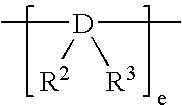Crystalline polymer of higher alpha-olefin and process for producing the same
a technology of alpha-olefin and crystalline polymer, which is applied in the field of crystalline polymer of a higher alpha-olefin, can solve the problems of non-uniformity, occurrence of stickiness, and polymers produced in the presence of such homogeneous catalysts
- Summary
- Abstract
- Description
- Claims
- Application Information
AI Technical Summary
Benefits of technology
Problems solved by technology
Method used
Image
Examples
production example 1
Production of 2-chlorodimethylsilyl indene
[0213] An one-liter three-necked flask was charged with 50 mL of THF (tetrahydrofuran) and 2.5 g (41 mM) of magnesium and then with 0.1 mL of 1,2-dibromoethane under a nitrogen flow, and the resultant mixture was stirred for 30 min to activate the magnesium.
[0214] After completion of the stirring, the solvent was removed from the mixture, and 50 mL of fresh THF was added thereto.
[0215] Then, a solution prepared by dissolving 5.0 g (25.6 mM) of 2-bromoindene in 200 mL of THF was dropped into the reaction mixture over 2 h.
[0216] After completion of the dropping, the reaction mixture was stirred at room temperature for 2 h and cooled to −78° C. Then, a solution prepared by dissolving 3.1 mL (25.6 mM) of dichlorodimethylsilane in 100 mL of THF was dropped to the reaction mixture over 1 h. The resultant reaction solution was stirred for 15 h, and then distilled to remove the solvent therefrom.
[0217] The obtained residue was extracted with 20...
production example 2
Production of (1,2′-dimethylsilylene) (2,1′-dimethylsilylene)-bis(indene)
[0218] An one-liter three-necked flask was charged with 400 mL of THF and 8 g of 2-chlorodimethylsilyl indene obtained in PRODUCTION EXAMPLE 1 under a nitrogen flow, and the resultant solution was cooled to −78° C. To the thus obtained solution was dropped 38.5 mL (38.5 mM) of a THF solution of LiN(SiMe3)2 (1.0 mol / L).
[0219] The obtained reaction solution was stirred at room temperature for 15 h, and then distilled to remove the solvent therefrom, and further extracted with 300 mL of hexane. The solvent was distilled away from the resultant extract to obtain 2.0 g (6.4 mM) of (1,2′-dimethylsilylene) (2,1′-dimethylsilylene)-bis(indene)(yield: 33.4%).
production example 3
Production of (1,2′-dimethylsilylene) (2,1′-cdimethylsilylene)(indenyl)(3-trimethylsilylmethylindenyl) zirconium dichloride
[0220] A 200 mL Schlenk's bottle was charged with 50 mL of ether and 3.5 g (10.2 mM) of (1,2′-dimethylsilylene)(2,1′-dimethylsilylene)-bis(indene) obtained in PRODUCTION EXAMPLE 2 under a nitrogen flow.
[0221] After the content of the bottle was cooled to −78° C., 12.8 mL of a hexane solution containing 1.60 M of n-butyl lithium (n-BuLi) was dropped thereto.
[0222] The resultant reaction mixture was stirred at room temperature for 8 h, and then the solvent was distilled away therefrom. The obtained solid was dried under reduced pressure to obtain 5.0 g of a white solid.
[0223] The white solid was dissolved in 50 mL of THF, and then 1.4 mL of iodomehyltrimethylsilane was dropped to the obtained solution at room temperature.
[0224] The resultant reaction solution was mixed with 10 mL of water, and an organic phase thereof was extracted with 50 mL of ether. The ob...
PUM
| Property | Measurement | Unit |
|---|---|---|
| temperature | aaaaa | aaaaa |
| temperature | aaaaa | aaaaa |
| temperature | aaaaa | aaaaa |
Abstract
Description
Claims
Application Information
 Login to View More
Login to View More - R&D
- Intellectual Property
- Life Sciences
- Materials
- Tech Scout
- Unparalleled Data Quality
- Higher Quality Content
- 60% Fewer Hallucinations
Browse by: Latest US Patents, China's latest patents, Technical Efficacy Thesaurus, Application Domain, Technology Topic, Popular Technical Reports.
© 2025 PatSnap. All rights reserved.Legal|Privacy policy|Modern Slavery Act Transparency Statement|Sitemap|About US| Contact US: help@patsnap.com



